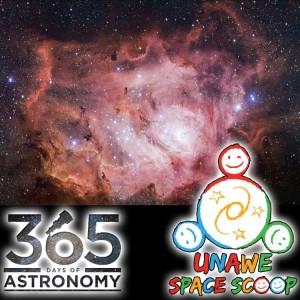Podcaster: Richard Drumm
Title: Space Scoop: Through the Looking Glass
Organization: Astrosphere New Media
Link : astrosphere.org ; http://unawe.org/kids/unawe1402/
Description: Space scoop, news for children.
Bio: Richard Drumm is President of the Charlottesville Astronomical Society and President of 3D – Drumm Digital Design, a video production company with clients such as Kodak, Xerox and GlaxoSmithKline Pharmaceuticals. He was an observer with the UVa Parallax Program at McCormick Observatory in 1981 & 1982. He has found that his greatest passion in life is public outreach astronomy and he pursues it at every opportunity.
Today’s sponsor: This episode of “365 Days of Astronomy” is sponsored by — no one. We still need sponsors for many days in 2013, so please consider sponsoring a day or two. Just click on the “Donate” button on the lower left side of this webpage, or contact us at signup@365daysofastronomy.org.
Transcript:
This is 365 Days of Astronomy. Today we bring you a new episode in our Space Scoop series. This show is produced in collaboration with Universe Awareness, a program that strives to inspire every child with our wonderful cosmos.
Today’s story is: Through the Looking Glass
 The ability to see things far beyond human vision has always fascinated people. Since their invention over 400 years ago, telescopes have been built in many shapes and sizes, and for many different uses.
The ability to see things far beyond human vision has always fascinated people. Since their invention over 400 years ago, telescopes have been built in many shapes and sizes, and for many different uses.
Not many people know this, but the first telescopes were created by the Dutch sometime around 1600 to 1608 and were basically military technology used to spot far-off enemy ships. Back then, telescopes were called “looking glasses”.
Glass mirrors were called looking glasses too. Lewis Carroll’s 1871 book “Through the Looking Glass, and What Alice Found There” (the sequel to “Alice’s Adventures in Wonderland”) had Alice stepping into the reflection of a mirror to start her magical journey.
The first person to point a looking glass telescope at the night sky was the English scientist Thomas Harriot (he called it a “perspective tube”) and it was he who drew a map of the Moon on July 26, 1609. The famous Italian scientist, Galileo Galilei was the first to publicize his systematic scientific observations which came several months after Harriot’s in the fall and winter of 1609.
With his higher quality telescope, Galileo became the first person to see many amazing features of our Solar System, including craters on the Moon, the phases of Venus and Jupiter’s four largest moons. Harriot had seen what he called a “strange spottedness” on the Moon, but couldn’t see it well enough to understand the shape of the craters.
Galileo, with his better telescope and his artist’s eye, correctly interpreted the chiaroscuro (or the interplay of light & shadow over an object)… the chiaroscuro of the Moon’s craters and mountains, showing us that the Moon was not the perfect sphere that Aristotle had claimed.
Just like 400 years ago, astronomers today use telescopes to reveal secrets hidden from the human eye. One example is a survey telescope called the VST at the Paranal Observatory in Chile which is being used to peer into the depths of our Galaxy, the Milky Way. The VST is mapping our cosmic neighborhood to help us understand how that very neighborhood came to be.
One of the many impressive sights in the Milky Way is the Lagoon Nebula. The album artwork for today’s episode demonstrates the impressive panoramic (wide-angle) photographs the VST can make. It shows the Lagoon Nebula, a gigantic cloud of gas and cosmic dust stretching 100 light years across. That’s 5 million times bigger than the distance between the Sun and the Earth!
The VST is a survey telescope, which is why it can see such large parts of the sky at once. It is designed to collect huge amounts of information from the entire sky which is then made available for anyone to study.
Cool Fact: The VST is currently playing a role in three surveys, helping to unravel the mystery of dark matter, searching for rare objects, learning about the origin of our Galaxy and much more!
Thank you for listening to the 365 Days of Astronomy!
365 Days of Astronomy is a community podcast made possible thanks to the contributions of people like you. Please consider donating at 365DaysofAstronomy.org/Donate
End of podcast:
365 Days of Astronomy
=====================
The 365 Days of Astronomy Podcast is produced by Astrosphere New Media. Audio post-production by Richard Drumm. Bandwidth donated by libsyn.com and wizzard media. You may reproduce and distribute this audio for non-commercial purposes. Please consider supporting the podcast with a few dollars (or Euros!). Visit us on the web at 365DaysOfAstronomy.org or email us at info@365DaysOfAstronomy.org. In the new year the 365 Days of Astronomy project will be something different than before….Until then…goodbye

